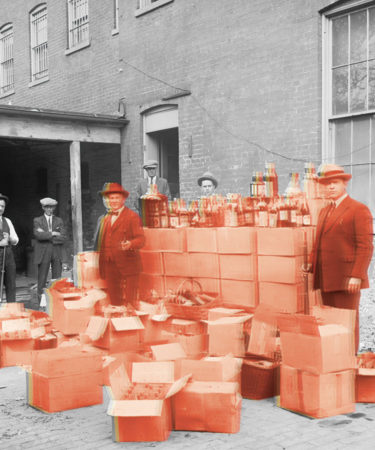The 18th amendment to the United States Constitution, commonly known as Prohibition, took effect on Jan. 17, 1920. Across the Atlantic, Scotch whisky producers coined their own nickname for the unwelcome legislation: “dry rot.”
As sympathy for the temperance movement grew worldwide, the British liquor industry feared its own government might follow suit. There was also the matter of widespread economic depression, leaving producers crucially dependent on hard-fought export markets, including the United States.
They needn’t have worried. The British government did not jump on the wagon, and Scotch exports declined less than 3 percent between 1920 and 1932. What’s more, during this time, the reputation of Scotch whisky improved in the United States, giving the spirit a huge advantage for when Prohibition was finally repealed in 1933.
Exactly how the Scotch industry managed such a feat is a seemingly unbelievable tale of barefaced whisky execs, infamous bootleggers, and world-famous Mafia bosses.
“During Prohibition, the demand for Scotch was undiminished, and indeed increased,” Charles Maclean, a Scottish whisky specialist and historian, tells VinePair. “Unlike bourbon, which was stamped on, and so-called ‘bathtub’ gin, Scotch was renowned for its quality.” The only problem was, unlike local moonshine, Scotch had to somehow cross the border into the United States for drinkers to enjoy and pay for it.
Rather than break the law and incur the wrath of the U.S. government, Scotch whisky exporters targeted territories neighboring the United States. Upon delivery to ports in Mexico, Canada, British Guyana, the West Indies (particularly the Bahamas), and St. Pierre and Miquelon, “a blind eye was cast upon how the goods reached the prohibited country,” Maclean writes in “Scotch Whisky: A Liquid History.”
Exports to these destinations boomed. In 1922, both Canada and the West Indies experienced a 400-percent increase in Scotch imports. Exports to Bermuda saw a staggering 4000-percent hike, while the Bahamas’ increase peaked at over 40,000 percent. The small French islands of St. Pierre and Miquelon, off the coast of Newfoundland, imported 119,000 gallons of Scotch that same year, which isn’t bad considering the territories had a combined population of 6,000 people.
From these locations, ships set sail for America laden with Scotch whisky, as well as other famous European and Carribean alcohol beverages. They stopped shy of territorial waters (between three and 12 miles from the coast) and off-loaded their cargoes onto awaiting speed boats that could dodge the U.S. Coast Guard.
Given the increased prices their bottles commanded, Scotch producers were worried their spirits might be tampered with, or “cut,” before they reached consumers. Led by the Distillers Company Ltd. (DCL), a trade cartel founded in Scotland in 1877 to control grain whisky prices, a number of prominent producers combined to form the “Scheduled Area Organization.”
“This organization would control prices and quality, regulate credit, and vet customers, who would be required to take a proportion of standard brands, alongside cheaper ones,” Maclean writes. “An intelligence network would be set up to ensure that interlopers were excluded as far as possible, and to check that whisky bought for other markets did not find its way to the bootleggers. Customers who breached the regulations would be deprived of supplies and credit.”
By all means, the intended customers were the criminal organizations running the illicit liquor trade. The “Combined” or “Big Seven Group” was formed to maintain the peace between rival gangs during Prohibition, and streamline the distribution of alcohol.
Members of the Big Seven included the likes of Charles “Lucky” Luciano and Frank Costello, an Italian-American crime boss synonymous with alcohol distribution. Costello formed a relationship with Scotch blender and spirits merchant, William Whiteley, and helped smuggle his blends into the United States via St. Pierre. By the time of repeal, Whiteley’s King’s Ransom blend was one of the world’s most famous and expensive bottles.
Another significant figure of the period was rum-runner William “Bill” McCoy. A former merchant navy sailor, McCoy established a business constructing luxury speed boats for millionaires in Jacksonville, Fla. But the allure of adventure and the huge financial gains of rum-running (a catch-all term for smuggling alcohol) led McCoy to enter the business himself.
McCoy pioneered a method of packing liquor and could store up to 5,000 cases on his schooner, the Arethusa. The expression “The Real McCoy” was used by fellow bootleggers to describe unadulterated spirits, particularly Scotch, because of the pride McCoy took in maintaining the quality of the name-brand liquors he transported.
By 1930, the Scottish whisky industry’s involvement in bootlegging had become something of an open secret — much like the alcoholic consumption in America itself.
As Maclean details in his book, during an exchange with the Royal Commission in Britain, Sir Alexander Walker (grandson of John “Johnnie” Walker) was asked: “Could you, if you would, as whisky distillers, stop a large proportion of the export of liquors to the United States?”
“Certainly not,” he replied, before clarifying: “We would not if we could.”
By all accounts, the Scotch whisky industry’s “controlled bootlegging” — as the practice was described by scholar Julie Brown — garnered long-term success. Prohibition ended in 1933. By 1938, exports of Scotch whisky from the United Kingdom had overtaken sales within the country. The formerly “dry” United States of America accounted for over 60 percent of the overseas market.
